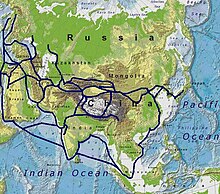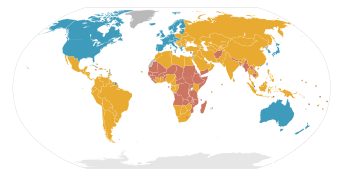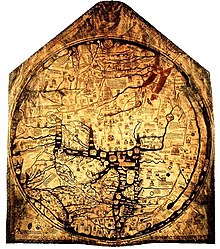Semi-periphery countries
Template:Sidebar with heading backgrounds
In world-systems theory, the semi-periphery countries (sometimes referred to as just the semiperiphery) are the industrializing, mostly capitalist countries which are in the process of transforming from periphery countries into core countries,regions that mix both core and peripheral forms of organization,regions spatially located between core and peripheral regions,regions spatially located between two or more competing core regions,regions in which mediating activities linking core and peripheral areas take place, and regions in which institutional features are in intermediate in form between those forms found in adjacent core and peripheral areas.[1].Semi-periphery is, however, not a descriptive category, but analytical tool to interpret change.[2] The World Systems Theory describes Semi-periphery as a key structural element in an world economy.[3] They function to play a vital role comparative to that of middle trading groups in an empire.[3] The term semi-periphery originates in the thirteenth century as Abu Lughod writes as the first true world system.[4]
Contemporary nations of the semi-periphery are industrialized.[5] Semi-periphery countries are major exporters of minerals and agricultural goods. They major in manufacturing and also export industrial goods and commodities,however, they lack the power and the economic dominance of core nations and still have a lot of unmanaged poverty.[2][6] They tend to be bigger in land mass, like for example China, because more landmass generally means a bigger market.
Function
The semi periphery is needed to stabilize the system.[7] It absorbs the shock between the low-income periphery states and the high-income core states.[7] Semi-periphery countries act as a peripheral zone for core countries and in some ways a core to periphery states.[8] They also serve as a "political buffer zone" in which they are the exploited and exploiters.[7] Some of these areas had been core-areas of earlier versions of a given world-economy.[7] Some had been peripheral areas that were later promoted, so to speak, as a result of the changing geopolitics of an expanding world-economy.[8]
Semi-periphery nations are a necessary structural element in a world-trade system.[7] They serve to let off the steam of the global political system. The semi-periphery can serve to the political pressures that the core can exert upon the periphery, and the political unrest that the periphery can direct back at the core.[7] On the other hand, the semi-periphery can find itself excluded from the political systems, as it lies just outside of the bounds of political arena of the core states.[7]
Origin in sociological theory
World-systems theorists originally used only the two categories - periphery countries and core countries, but a need for "in between" category became quickly apparent.[9] Hence the semi-periphery category was introduced for societies that moved away from the periphery but have not became core, in other words, societies that remained dependent, and to some extent underdeveloped, despite having achieved significant levels of industrialization.[10] As well,semi-peripheral countries are tied into dynamic world-systems that focus on the reliance of poor nations upon the wealthy, also known as the dependency theory.[11]
13th century

This era of human history found semi-periphery centralized to the East, stretching from the Middle East to China, including India and the Mongol Empire. This was also the first time in history that the peripheries and semi-peripheries of the world became connected and involved in the trade of the world, both with cores and with each other.[12] Through a lucrative trade system, including heavy taxing of goods traveling through their borders, they were abe to maintain a steady stream of wealth, becoming the driving forces of economic change throughout this time period. This is seen through Janet Abu Lughod's description of the changes when these areas were all conquered by one power [13]. In addition, a heavy emphasis on defense and border security, particularly among the Mongols, allowed them to be fairly impenetrable trade obstacles. Geography also played a role, as seen in India's use of an impressive maritime industry and convenient route through the Indian Ocean, estalishing their role as a "hinge" betwen the East and West.[4] Semi-peripheries in the Middle East also became crucially important in connecting the cities of Chinese and Indian cores with the fledgling cities of Europe, as well as serving as key points between other, more major core cities in the region.[4]
1875-1914

The West represented both the core, and the semi-periphery, as Europe dominated 80% of the world's market share.[14] The rest of the world was a diverse periphery, with the exception of only some nations, like Japan.[14] As expansionism continued, new core nations emerged, such as Britain, Germany, and the United States, while old cores such as Spain and Portugal faded to the semi periphery.[14] The growth of the power of the common man led to an expansion of thought concerning democracy, communism, and revolution, which pervaded the weaker semi periphery nations overcome with civil distress.[14] In some, this led to the weakening of the nations, such as the violent revolution in France.[14] This contributed to the adoption of totalitarian leaders, like in Germany and France.[14] The one the major factors contributing to world war were the conflicts and power struggles taking place between the three classes of nations in the global system.[14] Nations considered part of the Semi periphery felt oppressed by the stronger, larger core nations.[14]
Today

In today's global hierarchy, some states are transitioning upward while others are moving downward in terms of status and influence. Former colonial powers no longer exercise control over an international domain and are instead mostly relegated to their core; for example, former European world powers do not exert influence over colonial outposts in the Americas, Africa, or Asia, but rather have consolidated their power in the form of the European Union.[15] The new leading powers are mostly non-European (United States, China, Japan). Outside of these developed countries are a number of countries (see list below) that are considered semi-periphery and are both dominant and dominated within economic, political, and social realms. Some of these middle powers have emerged as a result of the fragmentation of the Soviet Union while others have risen because of their possession of resources in high demand, like oil in Saudi Arabia.[15] While these nations are by no means on the level of the stated world powers, they are able to exert influence over the weaker nations of the impoverished Fourth World.[citation needed]
Other terms used to describe semi-periphery countries include sub-imperial and semi-industrial.[15] Wallerstein identifies three ways by which countries can emerge from the periphery into the semi-periphery.[15] Countries with a large market and room for industrial growth, like Brazil, South Africa, and Mexico, and countries with valuable energy resources, like Iran and Saudi Arabia, can utilize the strategy of seizing the chance.[15] The strategy of promotion by invitation can be utilized by countries willing to be open to foreign governmental and regional administrative centers.[15] Examples of past countries to utilize this strategy are many of the capitalist regimes in Africa like Egypt, Kenya, Nigeria, Zaire, Senegal, and Ivory Coast.[15] These countries use dependent development to integrate into the world economy and establish local dominance. Outside of these strategies is that of self-reliance, a basic theory that as some countries grow, others will decline. Many countries in Africa and Latin America have exhibited the qualities of a sub-imperial or semi-industrial power.[citation needed]
Wallerstein examines the role of semi-periphery countries during a period of economic downturn,[8] certainly relevant in the current global economy. To redefine core and periphery countries in an economic sense, core countries are characterized by advanced technology, high profits, high wages, and diversified production while periphery countries have less technology, low profits, low wages, and less diversified production.[8] Semi-periphery countries fall in the middle of these spectra, and their unique political and social structure place them in a position where they can best take advantage of economic downturns.[citation needed]
These economic downturns occur because of increased supply and decreased demand, which combine to create a shift in surplus and power to the semi-periphery, who take advantage of the situation by expanding control of their home markets and the surrounding periphery countries at the expense of core countries.[8] The underlying reason for this shift in power lies in the basic economic principle of scarcity. As long as core countries maintain scarcities of their goods, they can select customers from semi-periphery and periphery countries that are competing over them. When excess supply occurs, the core countries are the ones competing over a smaller market, allowing semi-periphery nations to select from among core countries rather than vice versa when making decisions about commodity purchases, manufacturing investments, and sales of goods, shifting the balance of power to the semi-periphery.[8] While in general there is a power shift from core to semi-periphery in times of economic struggles, there are few examples of semi-peripheral countries transitioning to core status. To accomplish this, semi-peripheral nations must not only take advantage of weaker core countries but must also exploit any existing advantages over other semi-periphery nations.[8] How well they exploit these advantages determines their arrangement within the semi-periphery class.[citation needed]
Effects

The semi-periphery nations of the world have played an important role to world trade and interaction since early periods of globalized trade. This "middle ground" between the very powerful cores and the backwaters of the far periphery allowed those two zones to interact with greater ease. For example, during the 13th Century World System, the semi-periphery areas around Europe's Mediterranean Coast facilitated trade between the peripheries of the more manufacturing based Northern Europe and the cores of India and China.[4] John Markoff, a sociologist at the University of Pittsburgh also notes that most political developments, particularly in the advancement of democracy. He notes that most innovations in democracy came from the semi-periphery, rather than the more established, stable core nations, where profit discourages great reform, or the extremely poor periphery where instability makes reform too dangerous to attempt, so the semi-periphery nations where suffrage would be expanded, the secret ballot would be instituted, and so on with other reforms.[16]
Examples

Future
See also
Further reading
- Chase-Dunn and Thomas D. Hall, Rise and Demise: Comparing World-Systems, Boulder, CO: Westview Press.The Semi Periphery: The Seedbed of Change.Chapter 5 of C.
- Kaplan, David H.; Wheeler, James O.; Holloway, James O. Urban Geography. York, PA: John Wiley & Sons, Inc., 2004., pg. 412.
- Kees Terlouw, The Regional Reography of the World-system:External Arena,Periphery,Semi-Periphery,Core.(Utrecht:KNAG,1992),pg 36-45
- Immanuel Wallerstein, The Modern World-System: Capitalist Agriculture and the Origins of the European World-Economy in the Sixteenth Century. New York: Academic Press, 1976, pp. 229-233.
- Immanuel Wallerstein, The Modern World System: Capitalist Agriculture and the Origins of the European World Economy in the Sixteenth Century (New York: Academic Press, 1974).
- Semi-Peripheral Countries and The Contemporary World Crisis, Immanuel Wallerstein, Theory and Society,Vol.3, No.4.(Winter,1976),pp 461–483.
- Windows on Humanity by Conrad Phillip KOTTAK. Chapter 17, page 390.
References
- ^ Chase-Dunn and Thomas D. Hall, Rise and Demise: Comparing World-Systems, Boulder, CO: Westview Press.The Semi Periphery: The Seedbed of Change.Chapter 5 of C.
- ^ a b Kees Terlouw, The Regional Reography of the World-system:External Arena,Periphery,Semi-Periphery,Core.(Utrecht:KNAG,1992),pg 36-45
- ^ a b Immanuel Wallerstein, The Modern World-System: Capitalist Agriculture and the Origins of the European World-Economy in the Sixteenth Century. New York: Academic Press, 1976, pp. 229-233.
- ^ a b c d Janet Abu-Lughod. Before European Hegemony: the world system a.d. 1250-1350. New York: OUP, 1989. Print.
- ^ Semi-Peripheral Countries and The Contemporary World Crisis, Immanuel Wallerstein, Theory and Society,Vol.3, No.4.(Winter,1976),pp 461-483.
- ^ Immanuel Wallerstein, The Modern World System: Capitalist Agriculture and the Origins of the European World Economy in the Sixteenth Century (New York: Academic Press, 1974)
- ^ a b c d e f g Immanuel Wallerstein, The Modern World-System: Capitalist Agriculture and the Origins of the European World-Economy in the Sixteenth Century. New York: Academic Press, 1976
- ^ a b c d e f g h Immanuel Wallerstein, Semi-Peripheral Countries and the Contemporary World Crisis:Theory and Soiety, Vol.3,NO.4,(Winter, 1976),pp461-483
- ^ Chirot, Daniel. 1977. Social Change in the Twentieth Century. New York: Harcourt Brace Jovanovich.
- ^ Chirot, Daniel. 1977. Social Change in the Twentieth Century. New York: Harcourt Brace Jovanovich.
- ^ Tausch A., Social Cohesion, Sustainable Development and Turkey's Accession to the European Union: Implications from a Global Model
- ^ Janet Abu-Lughod. Before European Hegemony: the world system a.d. 1250-1350. New York: OUP, 1989. Print. pg 3.
- ^ Janet Abu-Lughod. Before European Hegemony: the world system a.d. 1250-1350. New York: OUP, 1989. Print.pg 154.
- ^ a b c d e f g h Hobsbawn, Eric. The Age of Empire. New York: Random House, 1987. Print.
- ^ a b c d e f g Shaw, Timothy M., "The Semiperiphery in Africa and Latin America: Subimperialism and Semiindustrialism," The Review of Black Political Economy: pp. 341-358. [1]
- ^ Markoff, John. Where and When was Democracy Invented. Comparative Studies in Society & History. 1999-1041:4
Warning: Default sort key "Semi-Periphery Countries" overrides earlier default sort key "International relations theory".
